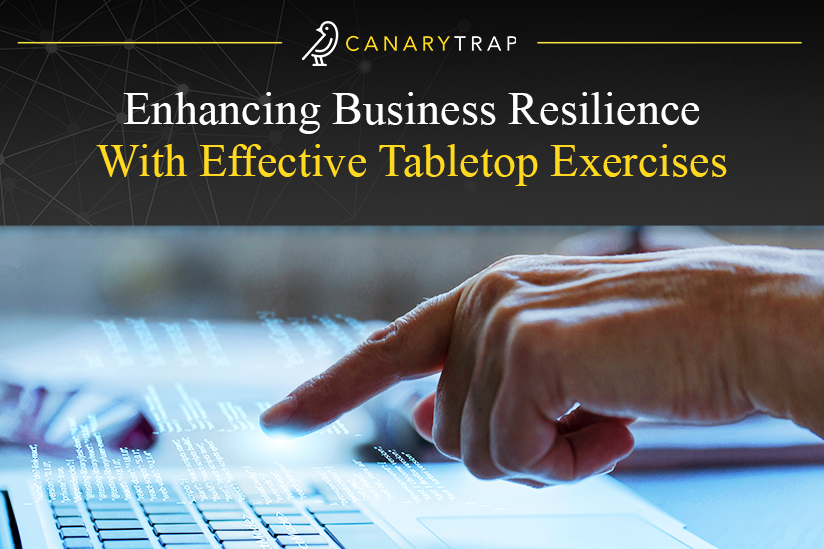Enhancing Business Resilience With Effective Tabletop Exercises
- July 6, 2023
- Canary Trap
In today’s rapidly evolving cybersecurity landscape, organizations face an ever-increasing risk of falling victim to cyber threats and incidents. To ensure preparedness and resilience, businesses must adopt proactive measures. One such effective approach is conducting regular tabletop exercises.
These simulated scenarios allow organizations to test their incident response plans, identify gaps, and fine-tune their strategies. In this blog post, we’ll delve into the importance of tabletop exercises and how they can fortify your organization’s defense against cyber threats.
What Are Tabletop Exercises and What Is Their Purpose?
Tabletop exercises are structured activities used to test the effectiveness of an existing plan or procedure in a low-stress, discussion-based format. These exercises involve a step-by-step simulation of a scenario, usually a crisis or emergency, that allows teams to consider their response strategies, roles, and responsibilities, without the pressure of an actual crisis. The purpose of tabletop exercises is to identify strengths and weaknesses in plans, improve coordination among teams, and increase awareness and understanding of potential crises.
According to Tom Jordan, collaborator at EdTech Magazine, “tabletop exercises help to improve an organization’s incident response, but they’re most effective when used as part of an overall preparedness framework. […]
Exercises done in the context of a cycle of planning, training and evaluation will lead to better outcomes.”
Different Types of Tabletop Exercises
Depending on the organization’s goals, different types of tabletop exercises may be employed, including:
- Policy-Based Exercises. These types of exercises focus on the organization’s procedures and guidelines during a crisis. They test the understanding and applicability of these policies.
- Procedure-Based Exercises. These are exercises aimed at understanding the specific actions and responsibilities of different roles during a crisis.
- Scenario-Driven Exercises. They are based on specific crisis situations, such as a cyber attack or natural disaster, allowing teams to test their responses in a more realistic context.
Choosing which type of tabletop exercise to conduct will ultimately depend on what aspects of crisis response an organization wants to test and improve. Organizations can either focus on any individual type of tabletop exercise or combine all of them for better results depending on their needs.
The Benefits of Regular Tabletop Exercises
When discussing the benefits of conducting regular tabletop exercises, Privacy and Data Security experts at HSE Law mentioned that “with all that focus—and spending— on artificial intelligence, it’s sometimes easy to forget about the importance of developing actual intelligence—of humans, that is. Conducting regular table-top drills to test and expand the knowledge of incident responders and the strength of incident response plans doesn’t cost much, but it does wonders maximizing incident response efficiencies and minimizing confusion in the wake of an incident.”
Let’s take a look at some of the main benefits of tabletop exercises as a key cybersecurity process:
- Improve Crisis Preparedness
One of the main benefits of regular tabletop exercises is that they significantly improve an organization’s preparedness for potential crises. By simulating different emergency scenarios, these exercises allow teams to test their response plans and strategies, identify potential weaknesses, and make necessary improvements. This proactive approach can significantly reduce the impact of an actual crisis on the organization’s operations, reputation, and bottom line.
- Enhanced Interdepartmental Communication
Tabletop exercises often involve representatives from different departments within an organization. By facilitating a collaborative dialogue about crisis response, these exercises can significantly improve communication and cooperation among these departments. They can help break down silos, build mutual understanding, and promote a coordinated and efficient response to crises.
- Identification and Mitigation of Gaps in Plans
No matter how comprehensive your crisis response plan may seem, it’s impossible to identify all potential issues until it’s put to the test. Tabletop exercises allow organizations to discover gaps or shortcomings in their plans in a controlled environment, where they can address them without serious consequences. This iterative process of testing and improving the plan can make it more robust and effective.
- Regulatory Compliance
In certain industries, conducting regular crisis response exercises may be a regulatory requirement. Even when it’s not mandatory, demonstrating that your organization has a tested crisis response plan can improve your standing with regulators, partners, clients, and other stakeholders.
- Increased Employee Awareness and Confidence
Tabletop exercises are a powerful tool for increasing employees’ awareness of potential crises and their roles in managing them. These exercises can also build confidence among team members by giving them a chance to practice their response in a low-pressure situation. As a result, they’ll be better prepared and less likely to panic or make mistakes in an actual crisis.
Overall, the benefits of conducting regular tabletop exercises are numerous and significant. These exercises can enhance your organization’s resilience, efficiency, and reputation, among other advantages.
What Is It Like to Design a Tabletop Exercise?
Designing an effective tabletop exercise requires careful thought and planning, so when undertaking such a task, organizations should follow a list of simple steps to ensure they can actually learn from the exercises:
- Identify Relevant Scenarios. Begin by identifying potential crisis scenarios that your organization could realistically face. This could be anything from a cybersecurity breach, physical security incidents, and natural disasters, to public relations crises. It’s essential to tailor these scenarios to your organization’s specific industry, size, and geographical location.
- Develop the Simulation. Once you’ve identified the scenarios, it’s time to develop a detailed narrative for each one. This should include an unfolding situation, potential impacts, and the expected response from your organization based on existing plans and procedures.
- Define the Objectives. Clearly define what you hope to achieve with each exercise. It could be testing a particular aspect of your response plan, improving interdepartmental communication, or assessing decision-making processes.
- Establish the Rules. Make sure the participants understand the format and rules of the exercise. This includes the flow of the simulation, the role of the facilitator, and the expected participation from team members.
- Prepare Materials. Prepare any materials needed for the exercise, such as incident logs, situation updates, or simulated news reports. These materials will add realism to the exercise and prompt participants to respond as they would in a real crisis.
Remember, the goal of the exercise is to test your response strategies in a safe environment, identify potential gaps, and learn from the experience. Make sure the exercise is realistic, but not so complex that it becomes unmanageable or discouraging for the participants.
How to Facilitate a Tabletop Exercise
A successful tabletop exercise requires a skilled facilitator who can guide the participants through the scenario, provoke discussion, and keep the exercise focused and productive. The facilitator should encourage participants to think critically, ask probing questions, and consider different perspectives.
After the exercise, the facilitator should also lead a debriefing session to review the results, identify lessons learned, and discuss any necessary updates to the crisis response plan.
Boris Khazin, cybersecurity expert and Global Head of Digital Risk Management & Governance, Risk, and Compliance services at EPAM adds: “a trusted cybersecurity partner will have an honest and objective view of a business and can provide the greatest challenge for information security teams. […] A third party or trusted partner can also give an unbiased assessment of a company’s current cybersecurity defenses, readiness and resilience.”
Tips for Effective and Engaging Tabletop Exercises
- Use multimedia resources, props, or role-playing to make the exercise more engaging and realistic.
- Involve a diverse group of participants to provide a wider range of perspectives and make the exercise more robust.
- Encourage participants to share their thoughts and ideas, even if they deviate from the current plan.
- The goal is not to “win” the scenario but to learn from it, so focus on what you need to fix or improve.
How Do You Know if a Tabletop Exercise Is Successful?
The success of a tabletop exercise should be determined by the insights gained and the improvements made to your crisis response plan, rather than the participants’ performance during the exercise. Here’s how to evaluate the success of a tabletop exercise:
- Collect Feedback. After the exercise, ask all participants for their feedback, including what they thought went well, what they struggled with, and what they learned. This can provide valuable insights about the exercise and the areas that need improvement.
- Review the Exercise Objectives. Go back to the objectives that were defined at the start of the exercise and in case you didn’t achieve them, find out why. This can help you understand where your plans or procedures might need to be modified.
- Assess the Response Strategies. Review the strategies that were used during the exercise to see if they worked as expected or if you faced any challenges. Use those insights to refine your strategies and make them more effective.
- Identify Lessons Learned. What were the key lessons from the exercise? These could include gaps in your plans, communication issues, or areas where participants lacked knowledge or skills. Make sure these lessons are recorded and used to improve your crisis response.
Remember, the goal of a tabletop exercise is to learn and improve, so any exercise that achieves this is a success. Use the evaluation process to identify areas for improvement and update your plans and procedures accordingly.
How Can You Apply the Insights and Lessons Learned?
- Update Plans and Procedures
Use the insights gained from the tabletop exercise to update and enhance your crisis response plans, procedures, and protocols. Incorporate the lessons learned to address any identified gaps or weaknesses.
- Refine Communication Strategies
Improve communication channels, both within the crisis response team and with external stakeholders. Consider implementing clear lines of communication, establishing designated spokespersons, and enhancing methods of disseminating critical information.
- Enhance Training and Skill Development
Identify areas where additional training or skill development is necessary for team members involved in crisis response. Provide targeted training sessions or workshops to improve their knowledge and capabilities.
- Establish Corrective Actions
Determine specific corrective actions or measures to address the weaknesses or challenges identified during the exercise. Assign responsible parties and set timelines for implementing the corrective actions.
- Schedule Regular Exercises
Develop a plan to conduct regular tabletop exercises to sustain preparedness and continuously improve crisis response capabilities. These exercises can help validate the effectiveness of implemented changes, identify new areas for improvement, and maintain a culture of preparedness within the organization.
By evaluating tabletop exercise outcomes and applying the insights gained, organizations can refine their crisis response strategies, enhance coordination and communication, and ultimately bolster their overall resilience in the face of future crises.
In Summary
Conducting regular tabletop exercises is a proactive and effective strategy to enhance crisis preparedness within organizations. By simulating potential crisis scenarios in a controlled environment, tabletop exercises provide valuable insights, promote interdepartmental collaboration, and help identify and address gaps in crisis response plans.
By investing time and resources into these exercises, businesses can mitigate potential risks, strengthen their crisis response capabilities, and build a culture of preparedness. Embracing tabletop exercises as an ongoing practice will ultimately contribute to the resilience and success of organizations when facing unforeseen challenges.
SOURCES:
- https://edtechmagazine.com/higher/article/2022/10/importance-tabletop-exercises-higher-ed-it-teams-perfcon
- https://hselaw.com/news-and-information/in-the-news/this-is-not-a-drill-table-top-exercises-arent-just-a-good-idea-theyre-mandatory-for-many-organizations/
- https://securityboulevard.com/2022/03/the-importance-of-tabletop-cybersecurity-exercises/

